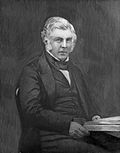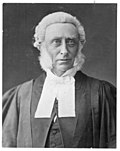The First Stafford Ministry was the third responsible government to be formed in New Zealand, and the first to last more than a few weeks. It formed in June 1856, and lasted until July 1861. As the office of Premier had yet to be established, Edward Stafford served as head of the government, although initially Henry Sewell was the Minister who reported to the Governor.[1]
Background
[edit]Stafford defeated William Fox 18–17 in a confidence motion based on the latter's proposal to give the provinces the bulk of state funding. He thereafter resigned the Superintendency of Nelson Province and formed a ministry including Henry Sewell, who was soon sent to London to negotiate a loan, and the detail-oriented William Richmond. Sewell became alienated from the ministry during his long absence and resigned a couple of months after returning in 1859. Meanwhile, Stafford followed a centralist policy: the government allocated a portion of land sale revenue to the provinces, ensuring that once the bulk of Crown land was sold, the provincial governments would struggle to raise enough revenue to survive; they also passed the New Provinces Act, permitting the break-up of the existing units into smaller and less powerful provinces.
The other main feature of the first Stafford Government was Māori policy, which was reserved to the Governor with the Ministry only being permitted to offer advice. In light of the rise of the Kingitanga, the Ministry favoured Francis Dart Fenton's scheme to create self-governing constitutional institutions for Maori, but was countermanded by Governor Thomas Gore Browne and his advisor, Donald McLean. In 1860 the First Taranaki War broke out over land sales conducted by the Governor's officials, leading to criticism of the Ministry's role. At the start of the 1861 session, Fox moved a confidence motion in the midst of the ramp-up of tensions in the Waikato, and won by two votes.[2]
Ministers
[edit]The following members served in the Stafford Ministry:[3]
| Name | Image | Office | Term |
|---|---|---|---|
| Edward Stafford |  |
Member of Executive Council | 2 June 1856 – 12 July 1861 |
| Colonial Secretary | 4 November 1856 – 12 July 1861 | ||
| Henry Sewell |  |
Colonial Treasurer | 2 June 1856 – 4 November 1856 |
| 25 February 1859 – 26 April 1859 | |||
| Member of Executive Council | 4 November 1856 – 26 April 1859 | ||
| Commissioner of Customs | 25 February 1859 – 26 April 1859 | ||
| Frederick Whitaker, MLC |  |
Attorney-General | 2 June 1856 – 12 July 1861 |
| William Richmond |  |
Colonial Secretary | 2 June 1856 – 4 November 1856 |
| Colonial Treasurer | 4 November 1856 – 25 February 1859 | ||
| 26 April 1859 – 12 July 1861 | |||
| Minister for Native Affairs | 27 August 1858 – 10 November 1860 | ||
| Commissioner of Customs | 1 January 1859 – 25 February 1859 | ||
| 26 April 1859 – 12 July 1861 | |||
| Member of Executive Council | 25 February 1859 – 12 July 1861 | ||
| John Logan Campbell |  |
Member of Executive Council | 2 June 1856 – 24 November 1856 |
| Henry Tancred, MLC |  |
Member of Executive Council | 5 August 1858 – 12 July 1861 |
| Secretary for Crown Lands | 19 August 1858 – 12 July 1861 | ||
| Postmaster-General | 3 November 1858 – 12 July 1861 | ||
| Lt. Colonel Robert Wynyard, CB |  |
Member of Executive Council | 3 January 1854 – 1 November 1858 |
| Col. Charles Emilius Gold | Member of Executive Council | 3 November 1858 – 30 March 1861 | |
| Frederick Weld |  |
Member of Executive Council | 28 July 1860 – 12 July 1861 |
| Minister for Native Affairs | 10 November 1860 – 12 July 1861 | ||
| Major-General Thomas Simson Pratt |  |
Member of Executive Council | 30 March 1861 – 22 April 1861 |
| Lieut-General Duncan Cameron |  |
Member of Executive Council | 22 April 1861 – 6 August 1862 |
See also
[edit]Notes
[edit]- ^ Bohan, Edmund (1994). Edward Stafford: New Zealand's First Statesman. Hazard Press. p. 97.
- ^ Bohan, Edmund (1994). Edward Stafford: New Zealand's First Statesman. Hazard Press. pp. 90–168.
- ^ Wilson 1985, p. 61.